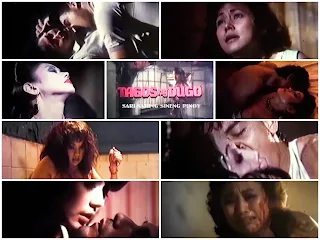The concept of Boy Kaldag (VMX, BLVK Films, Pelikula Indiopendent, 2024) is undeniably clever. Size is both the film's hook and flaw, an amiable but ambling comedy that collapses under extended exposure. Thankfully, there is more to Boy Kaldag than just its one-dirty-joke premise. A prodigiously endowed young man builds a reputation around his singular natural talent. People will always want sex and a man with a giant penis might not think it’s that crazy to try and make some money with it. Benz Sangalang is well-cast and interesting as Dax. He has an easy-going, casual style that fits the material. If Boy Kaldag is more often touching than salacious, it's because Sangalang imbues his character with such a palpable sense of yearning and regret, you end up rooting for him. Dax, in a voice-over explains what didn’t need to be explained. As he talks about the way things used to be, the tediousness of Dax’s interior monologue becomes funny. He winks at his failure to recognize how good he actually has it, making the viewer respond more tenderly toward him. The secondary characters include Jayner Santos as Gorgeous in a lovely comic performance filled with world-weariness that I found refreshing and largely believable. A farce with sensibility both mordant and whimsical, Boy Kaldag delights in its phallic symbols. So exuberant as to be unafraid of looking juvenile, it revels in illustrating the pathetic circumstances of Dax, whose only solace is being well endowed.
In fact, Boy Kaldag is less interested in its conceit than it is with what drove Dax to prostitution, the emotional baggage and the questions of morality that accompany the profession, which makes it far more interesting than one about a guy with a tripod plowing his way through lonely and horny women. Dax, faintly reminiscent of Dirk Diggler, Mark Wahlberg's porn star from Boogie Nights (1997), a big, slightly confused man without the slightest trace of self-doubt on board, a temperament that not coincidentally, is absolutely imperative in the man-whore trade. Because, let's face it, most regular, thoughtful men, men of ideas, men with flaws, would have more than a little trouble getting it up and keeping it up. Boy Kaldag gets a lot of elements right, including the baby steps it takes into Dax's new side. It's rather a rueful look at the lengths to which one guy will go to capture a life that has gradually slipped away from him. Director Roman Perez Jr.'s interplay, his willingness to let the story gradually unfold and its disarming sensitivity helps elevate Boy Kaldag well above its gimmicky title.That something, unsurprisingly and as unsubtle as you might expect from Boy Kaldag, is sex. Dax is the meat and potatoes and it’s fascinating to watch him deal with different women. And that’s exactly where Boy Kaldag succeeds; when it stops pretending to be something more than it is, it gets back to guiltlessly pleasuring its audience.
Sound Design: Lamberto Casas Jr., Alex Tomboc
Music: Derek Margaja
Editor: Mai Calapardo
Production Designer: Mikey Red
Director of Photography: Rommel Sales, LPS
Screenplay: Ronald Perez
Directed By: Roman Perez Jr.



























